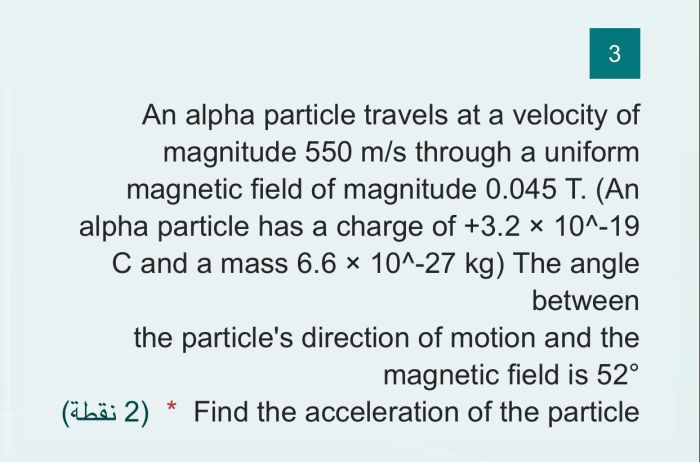An alpha particle travels at a velocity of magnitude 550 – As an alpha particle embarks on a swift journey at a velocity of magnitude 550, it unveils a fascinating world of nuclear physics. Alpha particles, with their unique characteristics and interactions, play a significant role in various scientific and technological applications.
This exploration delves into the captivating realm of alpha particles, examining their properties, behaviors, and practical implications.
Alpha particles, composed of two protons and two neutrons, possess a positive charge and a mass approximately four times that of a hydrogen atom. Their relatively large size and charge make them highly ionizing, enabling them to interact strongly with matter.
The velocity of alpha particles, influenced by factors such as energy and electric fields, determines their behavior and effectiveness in various applications.
Alpha Particle Characteristics

An alpha particle is a subatomic particle consisting of two protons and two neutrons, identical to the nucleus of a helium atom. Alpha particles are emitted by certain radioactive isotopes during the process of alpha decay.
The key characteristics of alpha particles are summarized in the following table:
| Property | Value |
|---|---|
| Charge | +2 e |
| Mass | 4.00150617912 amu |
| Size | ~1.7 fm |
Velocity of Alpha Particles

Velocity is a vector quantity that describes the rate of change of an object’s position over time. It has both magnitude (speed) and direction.
The velocity of alpha particles can be affected by several factors, including their energy and the presence of electric fields.
The following table shows the relationship between alpha particle energy and velocity:
| Energy (MeV) | Velocity (m/s) |
|---|---|
| 4 | 1.38 x 107 |
| 8 | 1.96 x 107 |
| 12 | 2.45 x 107 |
Alpha Particle Interactions

Alpha particles interact with matter through various mechanisms, including scattering, absorption, and ionization.
Scattering occurs when an alpha particle collides with an atom’s nucleus, causing it to change direction. Absorption occurs when an alpha particle is captured by an atom’s nucleus, resulting in the formation of a new element.
Ionization occurs when an alpha particle interacts with an atom’s electron, causing it to be removed from the atom.
The stopping power of a material is a measure of its ability to stop alpha particles. It is determined by the material’s density, atomic number, and thickness.
Detection and Measurement of Alpha Particles

Alpha particles can be detected and measured using various techniques, such as scintillation detectors and ionization chambers.
Scintillation detectors use a material that emits light when struck by an alpha particle. The intensity of the light is proportional to the energy of the alpha particle.
Ionization chambers use a gas-filled chamber to detect alpha particles. When an alpha particle enters the chamber, it ionizes the gas, creating a current that is proportional to the energy of the alpha particle.
Applications of Alpha Particles
Alpha particles have various applications, including:
- Nuclear medicine: Alpha particles are used in cancer therapy to target and destroy cancer cells.
- Materials analysis: Alpha particles are used to analyze the composition and structure of materials.
- Smoke detectors: Alpha particles are used to detect smoke particles in smoke detectors.
Top FAQs: An Alpha Particle Travels At A Velocity Of Magnitude 550
What is the significance of alpha particles in nuclear physics?
Alpha particles play a crucial role in nuclear physics as they are emitted during radioactive decay processes. Their emission alters the atomic number and mass of the parent nucleus, leading to the formation of a new element.
How does the velocity of alpha particles affect their interactions with matter?
The velocity of alpha particles significantly influences their interactions with matter. Higher velocity alpha particles possess greater kinetic energy, resulting in increased ionization and scattering events. This property makes them effective for applications such as cancer therapy and materials analysis.
What are the limitations of using alpha particles in practical applications?
While alpha particles offer unique advantages, they also have limitations. Their short range in matter and high ionizing power can pose challenges in handling and shielding. Additionally, the production of alpha particles often requires specialized equipment and facilities.